Before I write these From the Editor pieces, I obviously have to come up with something to write about. If nothing comes to mind quickly, I’ll look around my shop, the garage and outdoor places where I keep my boats, my digital photo albums, and the attic where I have all of my slides of boat-related projects and travels. If I come up empty handed in my searches at home, taking a boat out often helps. Visiting a new body of water can provide me with some fresh perspectives, so I may scan the satellite imagery on Google Earth. As I was doing that last week, I noticed Swamp Creek, a small tributary to the Sammamish River. I had rowed, paddled, and motored the river countless times and had never noticed the creek. Its entrance, just a dimple on the right bank, had been all too easy to overlook from the river. I decided to take my Whitehall there to see if I could find and row the creek.
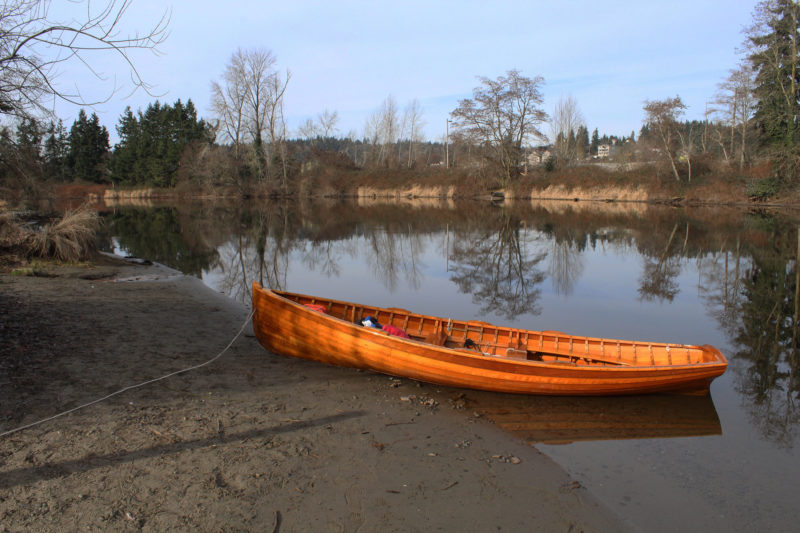
Lake Washington is just 1/3 mile around this last bend in the Sammamish Slough. On this Friday afternoon, I had the launch ramp and the slough to myself.
The public launch for the Sammamish River is 1/3 mile upstream from its meeting with the north end of Lake Washington. The water there is quite still, and only when the bow was resting on the back end of the trailer did the current slowly push the stern downstream. I pulled the boat up next to the ramp on sand that was smooth a few feet up from the water’s knife edge. It must have been washed over by the wake of a boat that had passed long before I had arrived. I parked the trailer, shoved off, and rowed upstream.
This section of the river I’d seen before. A mobile-home park crowds the right bank with double-wides clad in white metal siding and capped by low-pitched roofs. On the left bank there are two-story houses set back from the river behind winter-bare 40′ high weeping willow trees, trunks and branches as jagged as lightning, and slender branchlets seemingly falling like rain.
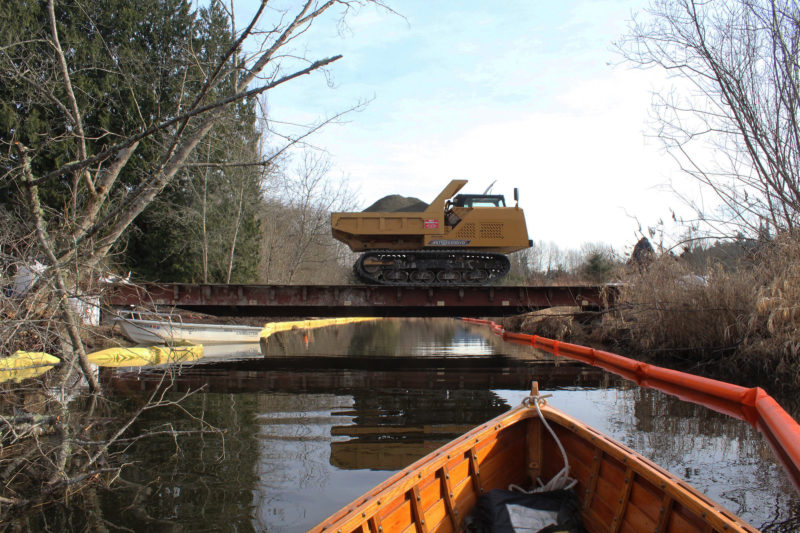
The bridge for the wetlands restoration project was dropped in place by crane and is supported by concrete blocks set below ground level. There was just enough clearance for me to slip through.
The entrance to Swamp Creek was hard to overlook this time. It was right at the edge of the mobile-home lot and there was a low steel bridge blocking its entrance. On top of the bridge an excavator with orange boom and silvery hydraulic piston rods was pawing at the ground on the south end of the bridge. Containment booms, orange on the left bank and yellow on the right, lined the first 100 yards of the creek.
I stopped a few boat lengths from the bridge eyeing the clearance beneath it There seemed to be just enough room for the Whitehall, so I waited to catch the eye of one of the three workers, who were all wearing white full-brim hard hats and were occupied with something on the left bank. The excavator crept across the bridge and onto the muddy ground on the north side and the bridge was clear, but only for a moment. A tracked dump truck crossed the bridge and stopped at its south end; its cab and dump box swiveled like an Army tank turret to face the opposite direction and it poured out a load of crushed rock. Emptied, it headed back across the bridge.
A worker wearing a Day-Glo lime-green vest looked my way and asked if I wanted to pass through. I saw the excavator heading for the bridge and said I’d wait until its weight was off it. The worker signaled to the excavator operator to stop and motioned me to go through. I hooked my toes under the thwart ahead of me and leaned back over the open space encircled by the sternsheets. The bow slipped under the middle girder, the lowest point of the bridge, with little room to spare. The worker, looking at me face to face as I coasted by, called out “Limbo!” The thick flange at the bottom of the girder passed by 2″ from my face. When I emerged on the other side and sat upright, two workers were watching me. One, dressed in dark-green overalls, asked “What are you up to?”
“I’m a magazine editor and I have to write an editorial this weekend. I haven’t come up with anything yet, so I thought I’d row the creek to see if something would come to mind.”
Upstream from the bridge, on the right bank, there were two more workers, one with a clipboard in hand. Next to them were the tangled roots of a 15′-long tree trunk set on its side, its top sawn off. The trunk was one of a half dozen neatly and evenly spaced on the muddy slope of the right bank. They made it evident that the work being done was a restoration of the stream and the wetlands surrounding it.
I kept rowing facing forward to maneuver around branches of half-submerged trees and piles broken just above the water.
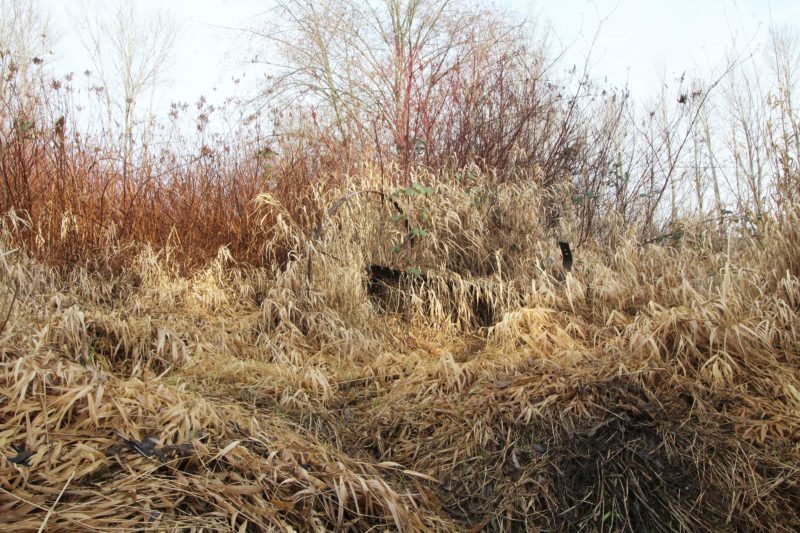
Almost lost in the grass above the right bank is a spring-tine harrow with one chest-high wheel remaining. The spring-steel support that once supported the seat is to the right of the wheel.
The creek ran straight for ¼ mile, and beyond the containment barriers the banks were mantled with thick mats of grass that winter had turned tan and softened so it could no longer stand. Clumps of it at the water’s edge, had been pushed downstream by a past high water and were ragged and curved like old straw brooms. The tips of the grass that touched the water gave the only indication of the stream’s flow—faint ripples that looked like paths left by water striders.
A sparse copse of spindly leaf-bare trees had lengths of corrugated black plastic drainpipe around their trunks, an indication that there were beavers in the area. A second cluster of trees a few dozen yards upstream had been surrounded by a fence of chicken wire and welded-wire mesh, but one of the wooden fence posts was broken and the section of fence it was holding up had collapsed. Only one of the trees in the enclosure was left standing; knee-high stumps were all that remained of the rest.
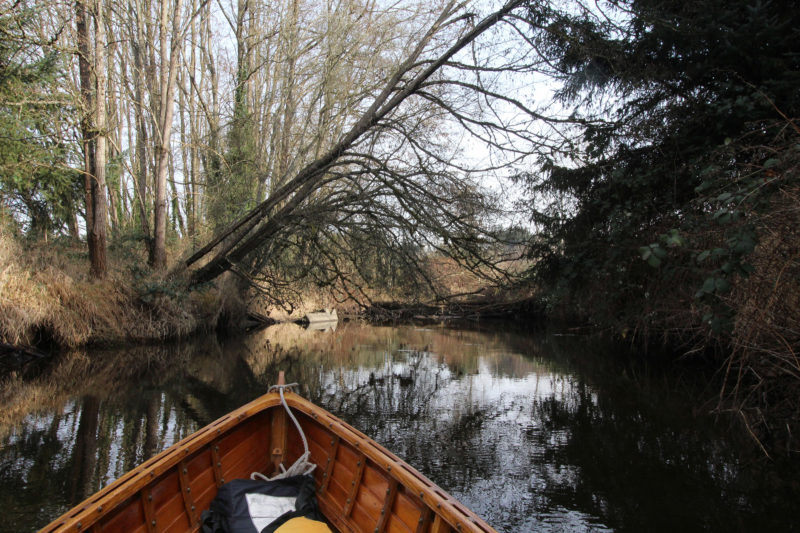
The end of the navigable section of Swamp Creek was just 1/3 mile upstream from its mouth.
A quarter mile from its mouth, the creek took a 45-degree turn from east to northeast and was cast in shadow by a stand of tall evergreens on the left bank. About 100 yards farther upstream, three locust trees on the right bank leaned across the river at a 45-degree angle, and their branches curved downward in dark lacy arches over the water.
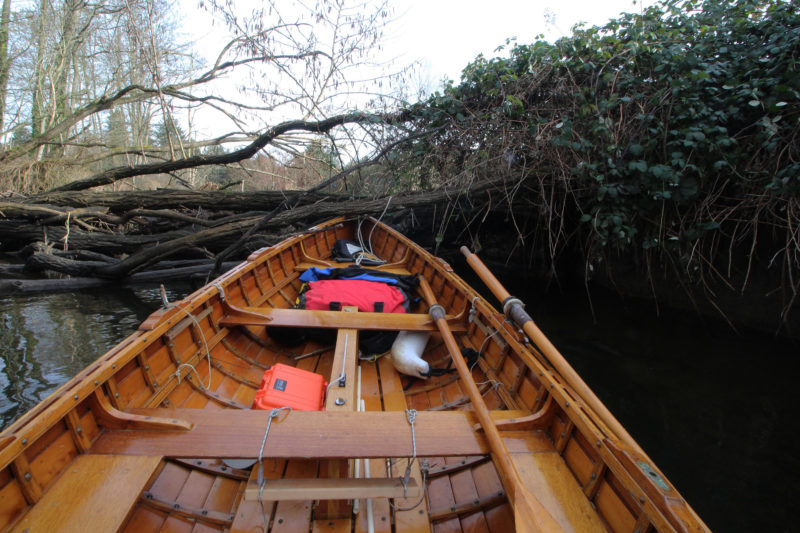
Fallen locust trees were the end of the line for my row.
I slipped past them and in another 20 yards stopped at an impassable barrier of locust trees that had fallen flat across the creek. Their bark was rough and fissured like scored bread crusts. Two branches on the uppermost horizontal trunk were growing straight up, becoming trees themselves with branches of their own reaching out in all directions.
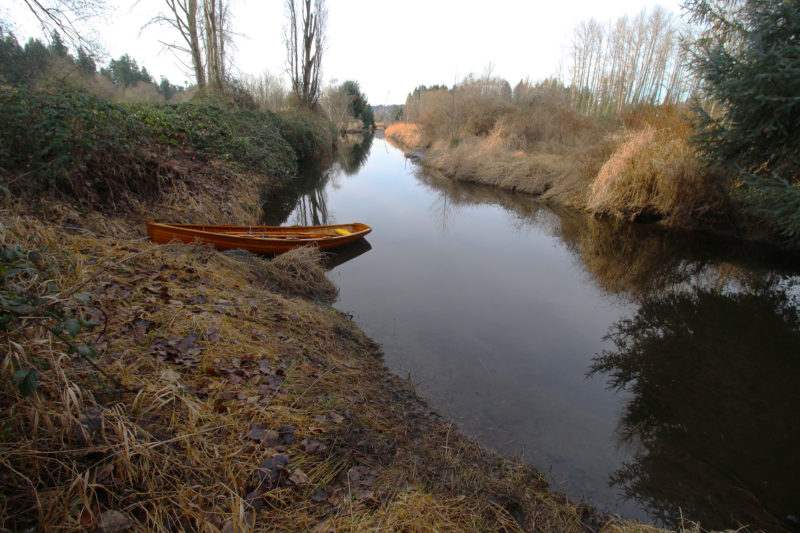
I pulled ashore to examine what appeared to be a path leading into the blackberry brambles. In the distance is the entrance to Swamp Creek, and a crane working on the wetlands restoration there is just visible against the sky and reflected in the water.
On my way back out, I stopped at the crook in the stream where there was a muddy streak leading from the water’s edge to a gap in the blackberry brambles on the left bank. While it looked like a footpath, there were no footprints and the muddied grass was not damaged but only pressed flat like slicked-back hair from the ’50s. It led into the brambles where no person could walk.
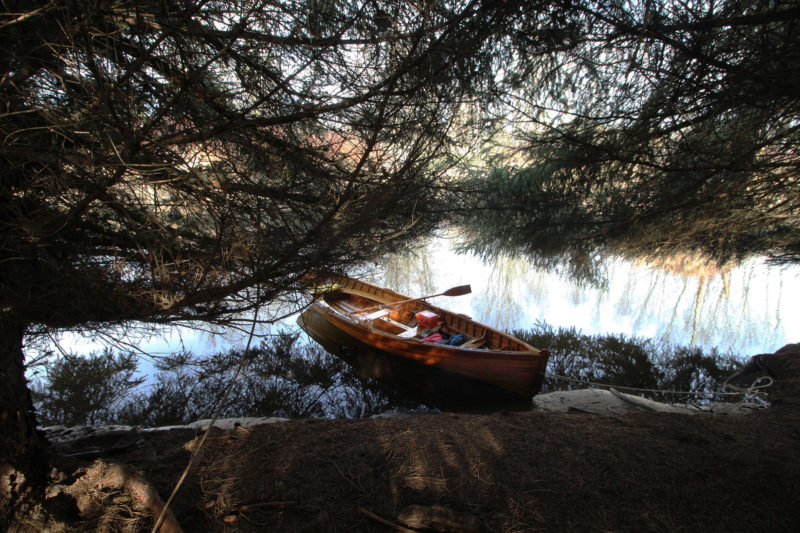
Where there were trees at the creek’s edge, the ground was clear but branches crowded overhead.
Another 120 yards farther downstream, I nosed the bow ashore where three blue spruce trees had their branches so thoroughly intertwined that no one tree could be distinguished from another. The ground beneath them was bare but for the umber-colored duff and looked like a good place to come ashore, but when I stepped out of the boat and climbed over the bank, I had to crouch down low to clear the plane of the lowest branches and even then, they scratched heavily across my back like a leaf rake.
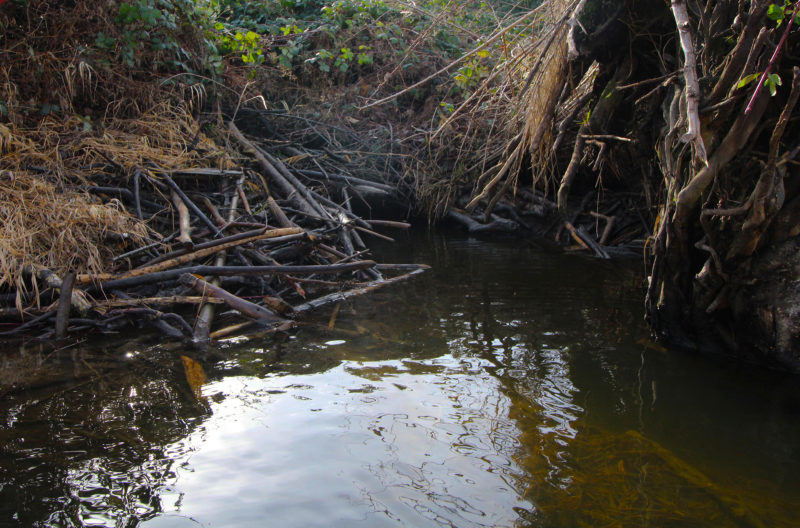
On the way out of the creek I saw what must be a lodge for beavers.
There was a clearing beyond the trees, a field of tawny leafed grass with a few clusters still standing and the rest carpeting the ground. I thought I would be able to walk across to the Sammamish, and at first it felt as if I were walking on a mattress but a few yards in the mat yielded even more and soon I could feel myself sinking deeper with each step. I turned around and went back to the boat.
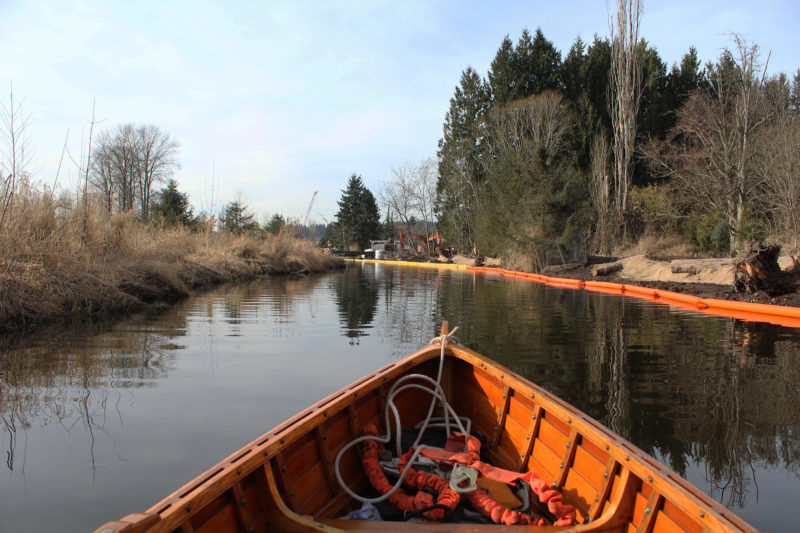
When I approached the creek’s entrance, the bridge was clear so I could get through quickly.
I continued rowing downstream. When I approached the bridge, the worker in the green coveralls was kneeling on the north side of the bridge, his front side bright with the blue-white light of arc welding. I passed under the opposite side and when I emerged, he had stopped welding and had his face shield flipped up over his head.
“What publication do you work for?”
“WoodenBoat.”
“Wind and Boat?”
I knocked on the Whitehall’s varnished gunwale. “WoodenBoat.”
As I rowed off, he flipped his shield back down with a nod of his head and went back to welding.
I shifted around to my normal rowing position, facing aft, and rowed back to the ramp. With the Whitehall strapped to the trailer and my gear in the truck, I drove home, still hoping something would come to mind.![]()

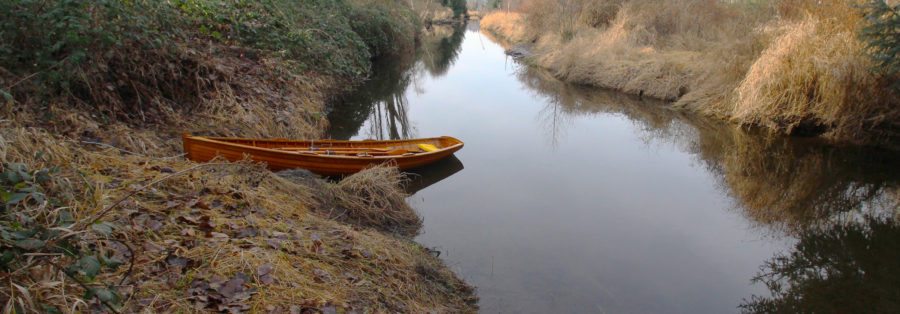
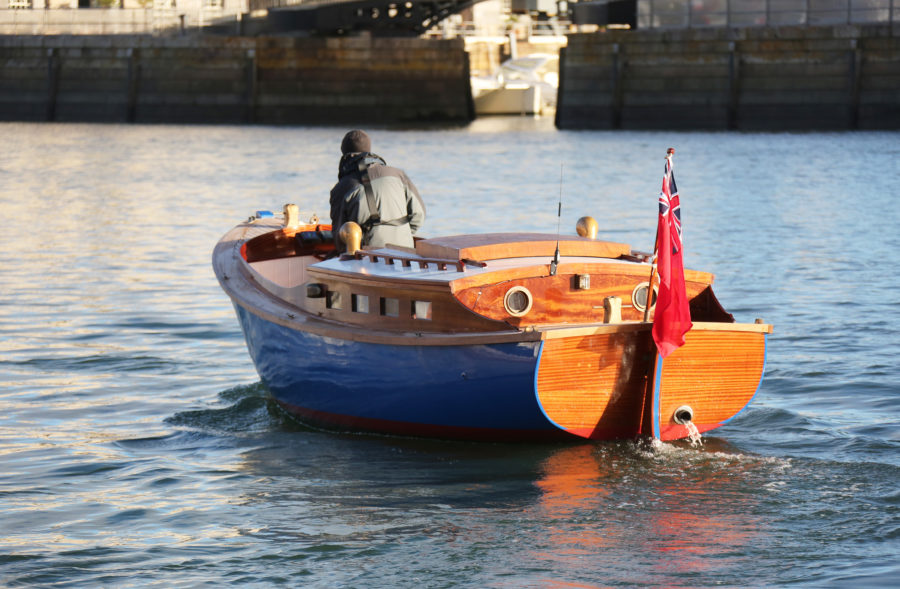
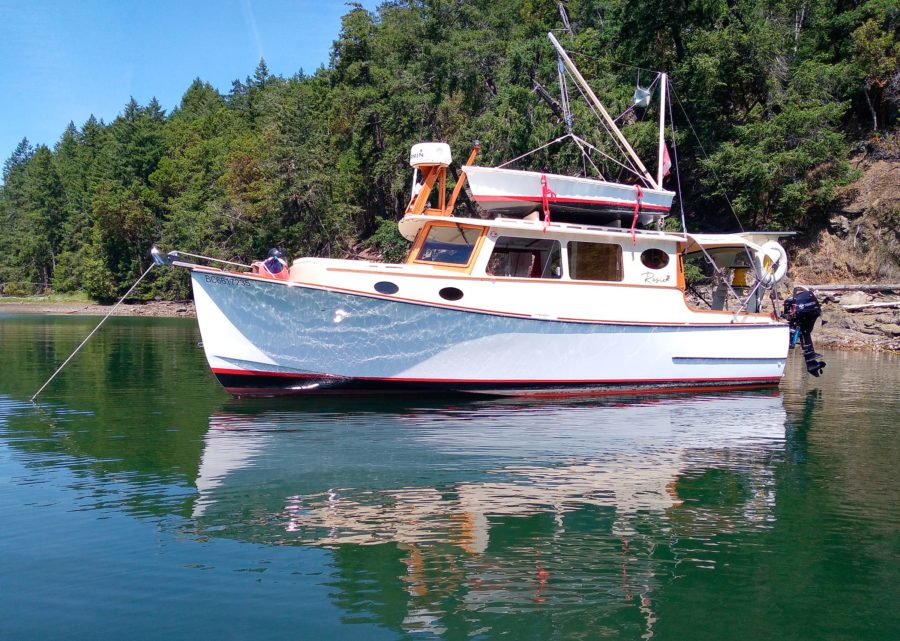
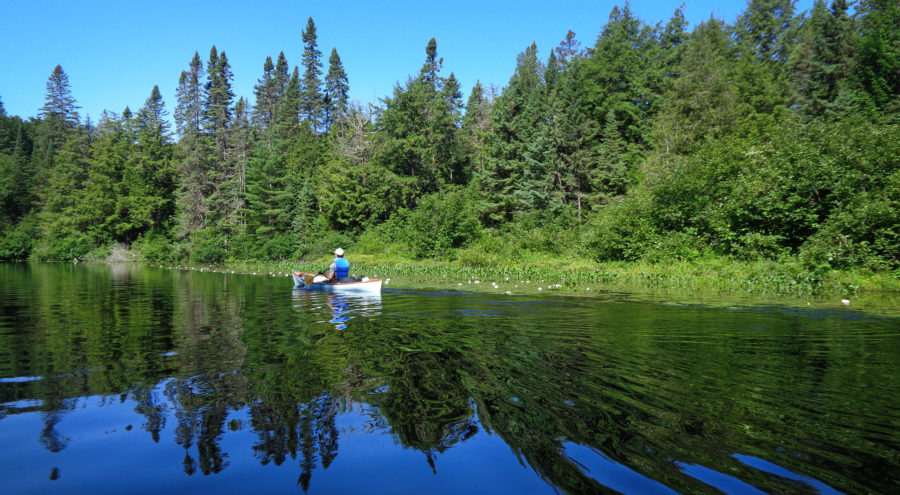
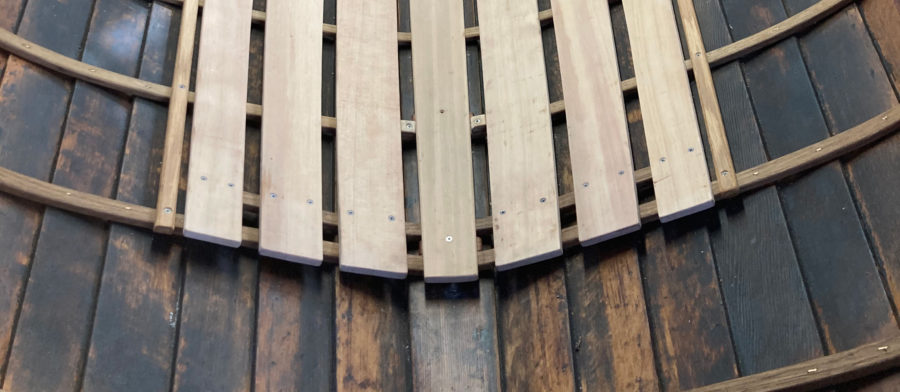
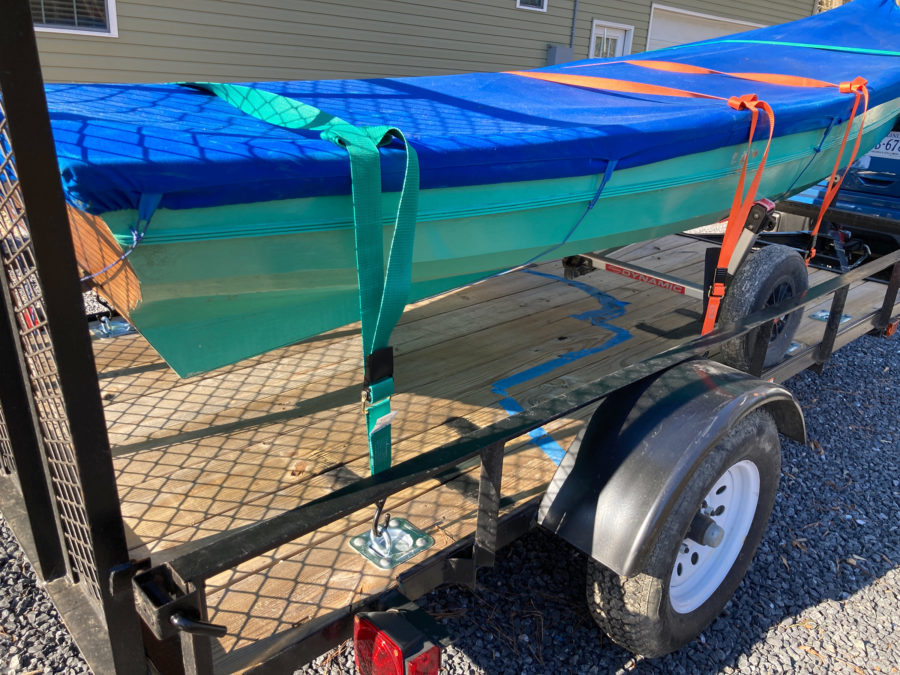
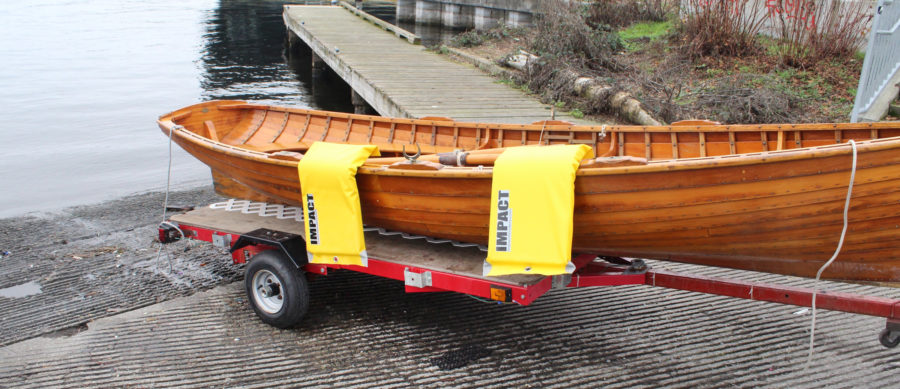
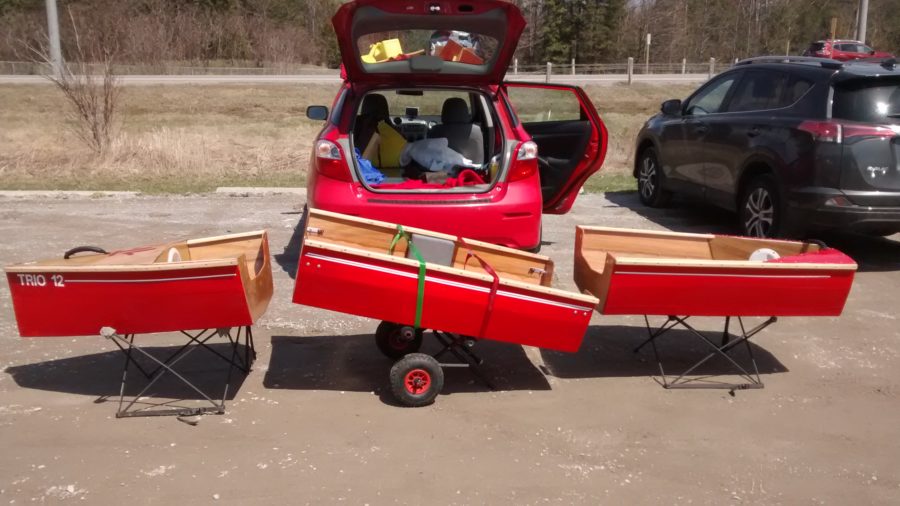
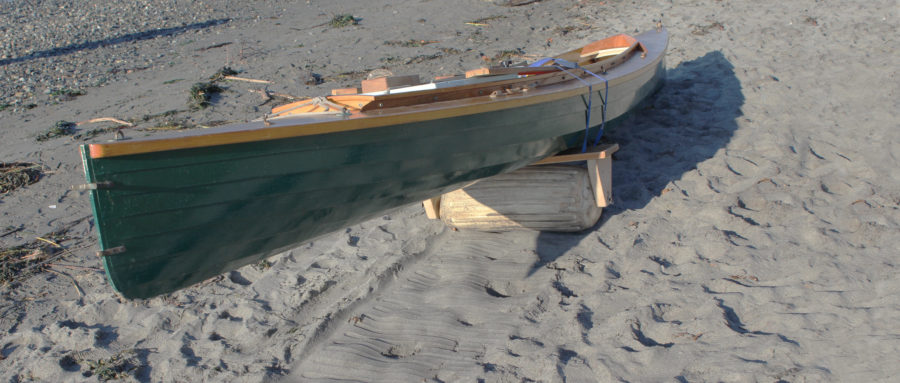
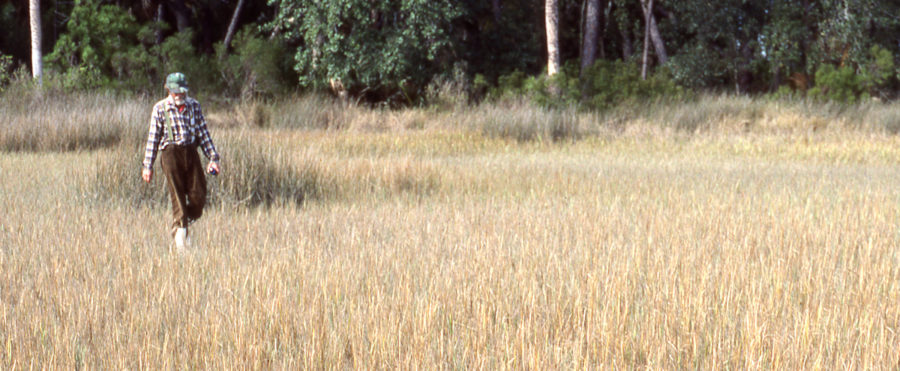
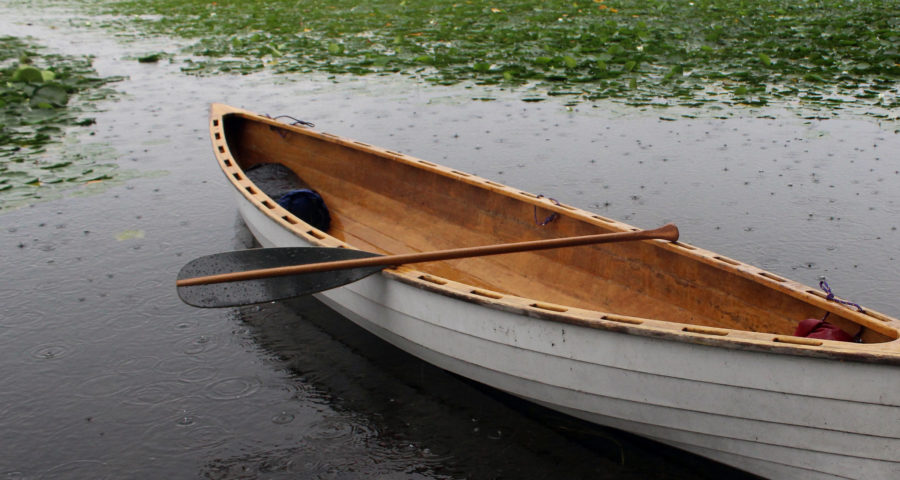
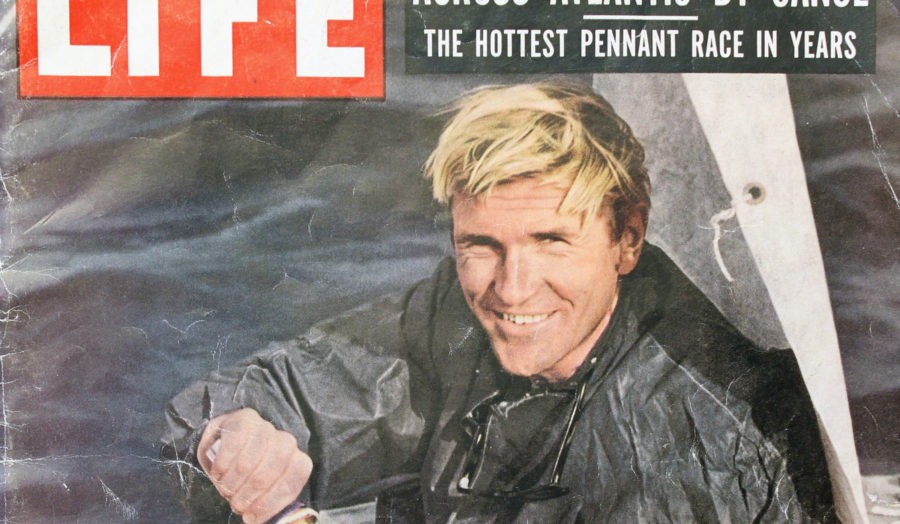
Great story, Chris. Hope something will come to mind for you eventually. It always amazes me that taking small waterways in an urban area can be so untraveled and with opportunities to see wildlife. Beaver in Seattle! Cool! On an afternoon’s canoe trip to a neighboring lake, I pushed on a loose log on beaver lodge with my paddle. Two beavers shot out under the canoe, freaking out my wife, who thought they might jump into the canoe. What a gorgeous Whitehall! Is that one you built?
Thanks
John
Urban exploring by water is the best. I have been slowly kayaking the waters behind Atlantic City this past year. Beyond the obvious intracoastal, the creeks through the marshes seem to go on forever.
Thank you for pointing this out for everyone, even the ugliest places have the prettiest spots if you are willing to look for them.
Thanks, John. I built the Whitehall to the plans for the New York Whitehall in Chapelle’s American Small Sailing Craft. I sold it a few years after I launched it and the boat came back to me when a second owner thought the boat should be back in my family. The hull is Port Orford cedar with a mahogany sheer strake and the knees and breasthook are all cut from crooks.
That is a gorgeous boat. Named?
The Whitehall started out as a commission, but the prospective owner had to bail out of the arrangement. Neither of the two owners that followed christened the boat, so it remains without a name. I suppose I should remedy that.
Thanks, this is my kind of adventure. In urban places waterways often provide access to areas that are private property by land, and the banks of streams and sloughs can be busy with wildlife. Near me on Suisun Slough there is a launch ramp, and the first side channel (named Hill Slough) requires passing under a narrow, low bridge opening into the shallow tidal slough. Not many people go there, so the local wildlife is mostly undisturbed. Last Fall during a high tide I took my solar electric skiff down to near the end, passing hawks, egrets, kites, otters and various shorebirds along the way.
Here’s a chart of Hill Slough.
A couple short videos, mostly to test out the new phone camera:
Hill Slough, Clouds
Hill Slough, Birds
Those beavers can be destructive little beggars! I had one munching on some trees at my beach last year.
I have a funny story about a dead beaver (not that it was funny that it was dead) my friend and I found at his property along the Yakima River, I will tell you sometime.
In my 50-year career in journalism I’ve been in this same fix quite a few times: deadline looming, nothing happening, no ideas germinating. It’s pointless to sit at your desk and stare at the blank screen until beads of blood appear on your forehead—nobody wants to read about your desperation. So you hit the road—or trail, or stream. Usually nothing dramatic happens, but if you’re a good observer, you can fashion a thoughtful essay out of the very ordinariness of what you encounter. There’s an infinite variety of insights into any ordinary place or thing; all we have to do is be receptive enough to find them.
A good reminder of the importance to make time to just get out there. Planning epic trips in glorious places is all well and good, but the essence of adventure is in the joy and challenge of the unexpected. If we don’t find time in our lives to simply follow the whims of curiosity, we miss out on little adventures.
It seems to me that adventure is best taken like food: Regular, moderate amounts leave us pleasantly satisfied, and ready to deal with the rest of life. Periods of starvation followed by binging leaves us alternately feeling hollow, then exhausted when we have too much to appreciate.
Adventure is best taken like food! Well said.